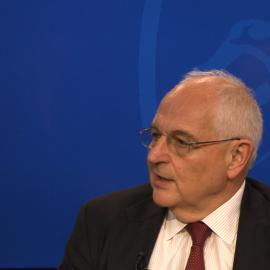To the Editor:
Richard Rhodes and Denis Beller are right that the world needs more energy ("The Need for Nuclear Power," January/February 2000). And nuclear energy has an important role to play, both globally and in the United States. But misleading arguments will not ensure that future. For instance, the authors write that nuclear recycling "could extend nuclear fuel supplies for thousands of years." Actually, recycling can extend nuclear fuel supplies by about 20 percent, but at a cost much greater than that of the uranium saved. It would take a widespread deployment of breeder reactors to extend nuclear fuel supplies by a factor of 100 or so.
It is true that "nuclear waste disposal is a political problem in the United States because of widespread fear disproportionate to the reality of risk." But it is a disjunction to then say that "it is not an engineering problem, as advanced projects in France, Sweden, and Japan demonstrate." The disposal of spent reactor fuel into mined geologic repositories is at least as far advanced as the ultimate disposal of the high-level wastes from reprocessing that will be needed in France and Japan. Not a ton of either of these materials has yet been permanently placed underground.
It is striking that "in equivalent lives lost per gigawatt generated (that is, loss of life expectancy from exposure to pollutants), coal kills 37 people annually; oil, 32; gas, 2; nuclear, 1." According to the U.N. Special Committee on the Effects of Atomic Radiation, the once-through approach provides a worldwide exposure to radiation of 152 person-sieverts (p-Sv), which at 0.04 lethal cancers per p-Sv means about 6 deaths ultimately (per 10,000 years). For the processing and recycling approach, the exposure is 341 p-Sv, or about 13 deaths per 10,000 years during the operation of a single power plant. Of these, fewer than 1 death occurs in the first 500 years for once-through, and about 1 death occurs for the recycle approach during the same time span. The authors must be ignoring deaths beyond the first 500 years.
Nor is it relevant that a "single mile of gas pipeline three feet in diameter at a pressure of 1,000 pounds per square inch (psi) contains the equivalent of two-thirds of a kiloton of explosive energy; a million miles of such large pipelines lace the earth." There is no conceivable mechanism to produce a gas explosion of that magnitude. It is equally misleading to say that a power reactor contains some two tons of uranium 235, which is the equivalent of 100 megatons of explosive energy.
Rhodes and Beller observe that "large nuclear power plants require larger capital investments than comparable coal or gas plants only because nuclear utilities are required to build and maintain costly systems to keep their radioactivity from the environment." But there is a good reason for this: they have a millionfold more radioactivity to retain.
Modern nuclear plants can be operated safely. But the industry continues to suffer from an unacceptable level of worker errors. The lack of quality control compromises safety. The pressure to cut costs has also led management at some plants to cut safety corners. And the Nuclear Regulatory Commission has imprudently allowed the industry to relax safety standards. Regulation must ensure that major accidents that release radioactivity to the environment -- like Chernobyl in 1986 -- do not happen again.
Nuclear energy in the short term needs access to proper storage for waste: competitive and commercial geological repositories for properly packaged spent fuel or reprocessing wastes (encased in glass and steel) from countries throughout the world. The long-term fuel supply for nuclear power is assured by the 4 billion tons of uranium in the oceans, available to any nation at a per-ton cost less than that of a ton of uranium saved by reprocessing and recycling nuclear fuel. Two billion tons would feed 5,000 nuclear plants (compared with the 430 that now exist) for 2,000 years. The use of breeder reactors would extend this resource for 400,000 years, but there is no reason to move to breeders during this millennium, since the spent fuel from reactors remains a resource for breeders.
Certainly, there is room for market-driven innovations in nuclear reactors and the fuel cycle, including reductions in radiation exposure from mining and milling and from reprocessing. But the availability of nuclear power to fill a portion of the world's energy needs does not depend on such innovations.
Richard L. Garwin
Philip D. Reed Senior Fellow for Science and Technology and Director, Science and Technology Studies, Council on Foreign Relations
